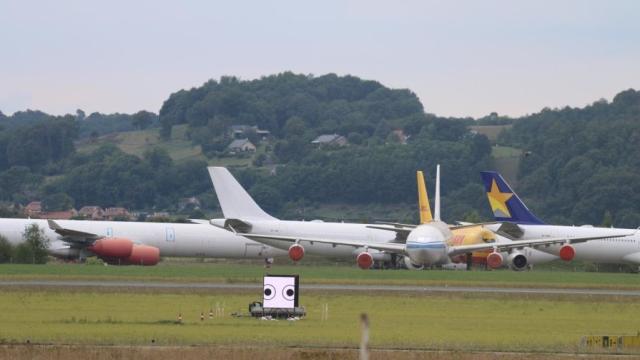Birds and planes are a bad combination, but it isn’t so easy to shoo our avian friends away from airport runways. Thankfully, scientists from France have stumbled upon an ingenious solution to the problem — an optical illusion that appears to scare the crap out of large predatory birds.
In addition to their sharp talons, strong claws and hooked beaks, raptors have incredible eyesight. Swooping high above the ground, these birds of prey can spot moving objects, such as mice and snakes, at great distances.
But their vision is far from perfect; raptors have a hard time detecting glazed surfaces, such as windows, and fast incoming objects, such as a jumbo jet, until it’s far too late.
Indeed, bird-on-plane collisions are a serious problem. In 2014, the US Federal Aviation Administration documented a whopping 13,159 incidents in which at least one bird smashed into an aeroplane, and at least 262 human deaths were linked to wildlife collisions from 1990 to 2016.
Sadly, measures to keep birds away from airports, such as silhouettes of humans, unpleasant noises, and disrupting the habitats of birds around airports, haven’t really worked.
In an effort to come up with a more effective strategy, a team of scientists from Centre National de la Recherche Scientifique (CNRS) and the University of Rennes, with some help from the Airbus corporation, applied their knowledge of avian physiology to the problem.
By exploiting the powerful visual system of raptors — a group of birds that includes eagles, falcons and hawks — the scientists were able to devise an optical illusion that effectively dissuades these birds from loitering around airports — and it looks suspiciously like a pair of googly eyes. These findings were published this week in PLoS One.
By applying pre-existing knowledge about raptor eyesight, the scientists studied the responses of these birds to various visual stimuli on a screen. After 300 tests, only one pattern triggered the desired avoidance behaviour: A pair of looming googly eyes.
By “looming”, the researchers are referring to a motion effect in which the image gradually grows larger over time. Doesn’t sound very threatening, but it likely presents an optical illusion to the raptors. The looming eyes trigger the impression of an imminent collision, likely with another bird.
The researchers refer to this kind of optical illusion as a superstimulus — a paradoxical effect “whereby animals show greater responsiveness to an exaggerated stimulus than to the natural stimulus,” in the words of the researchers.
Equipped with this finding, the researchers took their looming googly eyes to the real world, namely the the Lourdes-Tarbes-Pyrénées Airport — an area frequented by raptors and other birds. The researchers displayed the wide-eyed glare continuously throughout the day on a pair of strategically located LED screens.
Over the course of five weeks, the team recorded no less than 8800 bird sightings. The superstimulus worked remarkably well, with the scientists noticing dramatic drops in the population of birds within eyesight of the LED screens. Importantly, the birds showed no signs of becoming accustomed to the eyes, even after five weeks.
At the same time, the size of raptor populations in areas where the screens weren’t visible were normal, which the researchers took as further proof that the effect was working as intended.
For some reason, the googly eyes had the same effect on a group of corvids, a family of birds that includes crows. But the stimuli had no effect whatsoever on passerine birds, such as finches, songbirds and sparrows, which isn’t a complete surprise, given that they have different visual systems.
Let’s try to understand this illusion from a raptor’s perspective.
A raptor subject to this experiment would be minding its own business, searching for its next meal. Suddenly, it sees a pair of eyes glaring back at it. The scene fills the bird’s visual field. Worse, the eyes appear to be getting nearer. Thinking a collision with another bird is imminent, the raptor swoops away. The experience is probably unpleasant and unsettling enough to keep the birds away from the area.
At least, this is the theory behind the effect. The scientists aren’t entirely sure what the raptors are actually perceiving, and why the googly eyes present such a powerful deterrence. This visual stimulus may be “perceived as two big approaching eyes,” the authors write, “but why this might scare raptors and corvids” is a question worthy of “further experimental investigation”.
The authors admit that the findings are based on a single case study. It would be helpful to test the system at other airports and on other populations of birds, the authors say.
This study is “the first to demonstrate, on the basis of both captive and field studies and extensive data collection, the efficiency of a visual non-invasive stimulus to repel birds of prey and corvids from danger areas on an airport,” conclude the authors in the study.
This is an important finding, and not just because it can keep birds of prey away from airports. A similar system could be used to keep predatory birds away from wind turbines and other human-made hazards.
What’s more, this discovery is also telling us something new about raptor vision and avian behaviour. Scientists should definitely investigate this further to better understand why raptors have such a problem with these looming googly eyes.
[PLoS One]
